




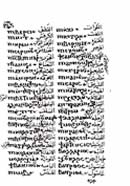
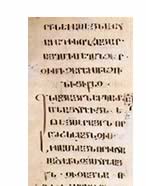

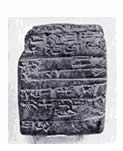


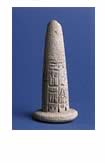





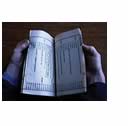






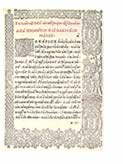

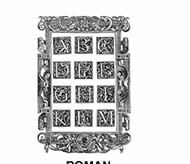



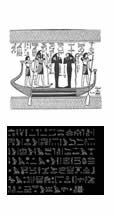


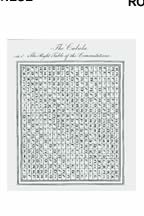







 |
 |
 |
 |
|||||||||||||||||||||||
 |
 |
 |
 |
 |
 |
|||||||||||||||||||||
 |
 |
|||||||||||||||||||||||||
 |
 |
|||||||||||||||||||||||||
 |
||||||||||||||||||||||||||
 |  |
 |
 |
|||||||||||||||||||||||
 |
 |
|||||||||||||||||||||||||
 |
 |
 |
 |
 |
 |
|||||||||||||||||||||
 |
||||||||||||||||||||||||||
 |
 |
 |
 |
 |
 |
 |
||||||||||||||||||||
 |
 |
 |
 |
 |
 |
|||||||||||||||||||||
ARABIC
Greg.de Gregoriis, Book of Christian Prayers in Arabic, printed
in 1514 and probably the first type fount in Arabic. A page from Ibn Kabr's
List of Vegetables , reproduced in E.Wallis Budge, The Divine Origin of
Herbcraft Dover, NY, 1996, originally the Society of Herbalists, London
1928 From the British Museum, Oriental MS collection. ARMENIAN
Armenian Uncial Script (Real Mesropian Erkat'agir) a detail
from an Armenian set of the gospels c1050 AD. ASSYRIAN
Assyrian/Babylonian Script - cuneiforms. A cone recording the building
of the Temple E-NinnuNingirsu, c2350 BC in Sumerian cuneiform. List of
plants in the Herb garden of Merodach-Baladan II, King of Babylon , reproduced
in E.Walis Budge, The Divine Origin of Herbcraft Dover NY 1996, originally
the Society of Herbalists, London 1928, and showing a document in the
British Museum Tablet 46226. An original Babylonian tablet of baked clay
inscribed in the cuneiform character (in the Sumerian language) with a
record of the receipt of 83 cattle including 11 fat sheep, 29 sheep, 10
ewes, she-goats and male kids for the service of the Temple. The record
was made by the scribe Nin Pa Mu Da, measuring 2 x 1.5 inches and c2250
BC. catalogued and reproduced in Maggs Brothers Sale catalogue "
The Art of Writing ", London undated (c1935) p.11. An original Babylonian
Cylinder Seal or Amulet in black haemetite dating from the period 2000
- 1800 BC ; two figures approach a deity with offerings, insc. "Yerim-elsu,
son of YaeriNabu, servant of his God." catalogued and reproduced
in Maggs Brothers Sale catalogue " The Art of Writing ", London
undated (c1935) p.15. CHINESE
1858 Chinese Almanack printed in Shanghai. An interesting arrangement
of characters and imagery on a page - from an edition of SAN KWO CHIH
, 17th century). Written charm for hastening the delivery of a baby from
Henry Dore (M.Kennelly trans) , Researches into Chinese Superstitions,
T'Usewei Printing Press, Shanghai 1914 First Part - Volume One illustration
page size 14 x 24cms. CYRILLIC from the sheet music to Glinka's Russian Polka of 1905. Plate from the Russian calligraphy book, Novaia Rossilskaia Azbuzka, St.Petersburg 1791 EGYPTIAN FROM E.Wallis Budge, The Egyptian Heaven and Hell, The Third Division of the Tuat - The Boat that capsizeth. FROM E.Wallis Budge, The Egyptian Heaven and Hell, a depiction and captioning The text talks of the facilities of the Heaven, called Sekhet-betepet (from inside a coffin lid). FROM E.Wallis Budge, The Egyptian Heaven and Hell, The Eighth Division of the Tuat - where the Sun God passes in the Eighth Hour of his journey. It reads, "The Majesty of this great god taketh up its place in the Circles of the hidden gods who are on their sand and he addresseth to them words in his boat whilst the Gods tow him along through the City by means of the magical powers of the serpent MEHEN." The Kingdom of Seker- the Sun God passes during the Fourth Hour of the Night.Here RA must pass over the terrain and the inhabitants. GREEK The Greek Alphabet from Juan de Yciar, Arte Subtilissima intitulada Orthographia Pratica , 1550. a page from an edition of Aristotle printed by the great Aldus of Venice (1495- 1498) and part of an extensive programme of printing definitive texts by Greek authors. Page from a PSALTERY, printed by Aldus of Venice , undated c1498. 14 x 26cms. HEBRAIC The Hebraic Alphabet / Kaballah from Giovanbattista Palatino, Libro Nuovo, Rome 1561. From Francis Barrett, The Magus of Celestial Intelligencer.. . 1801, the letters of the Hebrew alphabet written out in sequence for magical permutation. From Francis Barrett, The Magus of Celestial Intelligencer.. ., a rather muddled version of Cabbalistic philosophy published in London 1801, magical permutations of letters registering the names of the angels. INCA Quipu Raimondo di Sangro, Lettera Apologetica dell'Esercitato.... ,Naples 1750; this plate illustrates the range of symbolic knots (quipu) developed by the Incas, subdivided into sections of language - meaning and punctuation - by colour coding and shapes. The book also provides transliteration into European languages. HIEROGLYPHS reproduced from Elworthy's The Evil Eye , Murray London 1893 JAPANESE Japanese print by Tachibana no Binko, 1784, of a mirror polisher at work. ROMAN from Juan de Yciar, Arte Subtilissima intitulada Orthographia Pratica , 1550. |